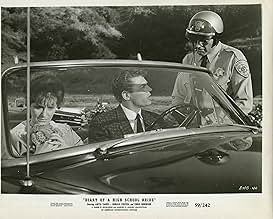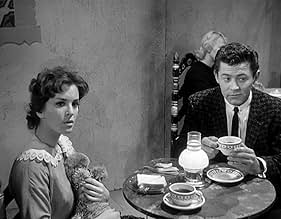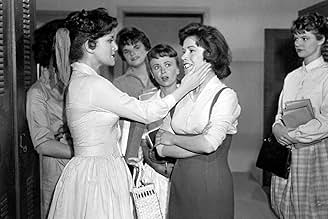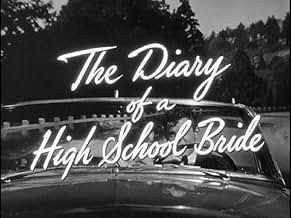Ajouter une intrigue dans votre langueA 17-year-old high-school senior must justify her wedding to a 24-year-old law student to both her parents and her unbalanced ex-boyfriend.A 17-year-old high-school senior must justify her wedding to a 24-year-old law student to both her parents and her unbalanced ex-boyfriend.A 17-year-old high-school senior must justify her wedding to a 24-year-old law student to both her parents and her unbalanced ex-boyfriend.
Ron Foster
- Steve
- (as Ronald Foster)
Frank Biro
- Mr. Lewis
- (as Barney Biro)
Dick Gering
- Richie
- (as Richard Gering)
Elvera Corona
- Dancer
- (as Elvira Corona)
Allan Lurie
- Tony
- (as Al Laurie)
Avis en vedette
This 1959 was most likely encouraged by all parents as a "must see" who had teenaged children who were a few years still away from full adulthood. In the 1950's and 1960's the man was almost always the bread winner and the woman were stay at home moms. Historically young women were in competition with one another to find that "big catch" of a man so marrying quite young was the norm. It also meant that woman felt their biological clock (and hormones) were most strong at the earliest of age to have babies.
This story pits a seventeen (17) year old teenager named Judy (Anita Sands) with two completely different male suitors. One is a rough and tumble ex boyfriend named Chuck (Chris Robinson), and the other is a more recent suitor an older and mature law student named Steve (Ron Foster).
The message and theme of the film is exposing the potential serious consequences of making rash and impromptu decisions at a very young age. Hormones are running rampant as is the testosterone of the virile young men who live either in the past and/or the present but not considering what the future will hold in store for their abrupt actions sometimes.
Thank goodness the pendulum has swung to the farther right these past seven (7) decades and young adults are waiting longer to tie the proverbial knot. Too bad divorce rates are running around fifty (50) percent today.
I give this crime/drama themed film a 6 out of 10 IMDB rating.
This story pits a seventeen (17) year old teenager named Judy (Anita Sands) with two completely different male suitors. One is a rough and tumble ex boyfriend named Chuck (Chris Robinson), and the other is a more recent suitor an older and mature law student named Steve (Ron Foster).
The message and theme of the film is exposing the potential serious consequences of making rash and impromptu decisions at a very young age. Hormones are running rampant as is the testosterone of the virile young men who live either in the past and/or the present but not considering what the future will hold in store for their abrupt actions sometimes.
Thank goodness the pendulum has swung to the farther right these past seven (7) decades and young adults are waiting longer to tie the proverbial knot. Too bad divorce rates are running around fifty (50) percent today.
I give this crime/drama themed film a 6 out of 10 IMDB rating.
This 1959 picture starts with a disclaimer stating, "Teenage marriage is one of today's most controversial subjects. The producers do not attempt to present a solution or take sides..."
The producers also take no sides, or seemingly have an issue, with a 24 year old man marrying a 17 year old girl.
Instead, they take the controversial topic and turn it into a pulpy melodrama aimed at the teenage drive-in theatre audience of the times.
Some of the film's elements border on the surreal. Take the beatnik coffee shop that doubles as a flamenco lounge. Or one of the establishment's customers who tunes out the live music, and the world around him, by hearing music from his transistor radio through ear "buds." Or, how about the 17-year old constantly cuddling her stuffed toy dog to symbolize her youth. On her wedding night the camera tilts down from her kissing her husband to her hand dropping the pooch and lingers on her wedding ring.)
Then, there's the psychotic ex-boyfriend. He can't stand that he never got to first base with the now newlywed and resorts to criminal behavior. One could say his actions symbolize the challenges the young couple faces, but, based on director Burt Topper's other work, I doubt the thought ever entered his mind.
The bride is played by Anita Sands who photographs beautifully. Her career, though, was short-lived as she retired from acting at the age of 23 and later became an astrologer to Hollywood stars.
The film is a curiosity for those interested in looking into Hollywood's handling of teen marriage in the 1950s and fans of the work of American International Pictures - the studio that built a mini-empire by focusing on films for young people.
The producers also take no sides, or seemingly have an issue, with a 24 year old man marrying a 17 year old girl.
Instead, they take the controversial topic and turn it into a pulpy melodrama aimed at the teenage drive-in theatre audience of the times.
Some of the film's elements border on the surreal. Take the beatnik coffee shop that doubles as a flamenco lounge. Or one of the establishment's customers who tunes out the live music, and the world around him, by hearing music from his transistor radio through ear "buds." Or, how about the 17-year old constantly cuddling her stuffed toy dog to symbolize her youth. On her wedding night the camera tilts down from her kissing her husband to her hand dropping the pooch and lingers on her wedding ring.)
Then, there's the psychotic ex-boyfriend. He can't stand that he never got to first base with the now newlywed and resorts to criminal behavior. One could say his actions symbolize the challenges the young couple faces, but, based on director Burt Topper's other work, I doubt the thought ever entered his mind.
The bride is played by Anita Sands who photographs beautifully. Her career, though, was short-lived as she retired from acting at the age of 23 and later became an astrologer to Hollywood stars.
The film is a curiosity for those interested in looking into Hollywood's handling of teen marriage in the 1950s and fans of the work of American International Pictures - the studio that built a mini-empire by focusing on films for young people.
Though made for a drive-in audience the movie's not typical of that often tacky fare. A few notes on historical context may help understanding aspects of the film.
Before the big Baby-Boomer Generation, there was the so-called Silent Generation. For obvious reasons, few now have heard of it. For kids coming of age, the period was from about 1950-65, and was called silent because the main ambition of the youngsters was to get married and get a job which were plentiful in that post-WWII era. The popular refrain of the time was "Are we too young to get married". In short, there was little gap between youth and adulthood. One motivating reason was that sex outside of marriage was strictly forbidden. Thus hormonally driven youth were sometimes thrust into early, unhappy marriages. This movie from that era (1959) dramatizes some of the prevailing aspects.
All in all, the movie's best at showing the strains on Steve's and 17-year old Judy's troubled early marriage, especially when she's required to do household drudgery—good touch. In short, being a housewife has a non-romantic downside. Her parents are disapproving of the youthful arrangement as would be expected. But their conniving is fairly subtle. Unfortunately, the movie was produced mainly for teen audiences, so the contrived role of hoodlum Chuck hassling the newly-weds takes up more time than it should, and represents a strictly commercial side. Nonetheless, moments of unexpected quality do pop up, especially in Sands' (Judy) performance dour though it often is. Also, the final shot is more ambiguous than I expected from this type movie. And catch that bang-up look at the intricacies of a movie studio serving as an action climax. For folks interested in modern mores, the film presents some insights, along with a fairly entertaining narrative..
(In passing—Note the semi-Beatnik coffee shop the kids gather at. I say "semi" since something more genuine would have featured jazz, bongo drums, and poetry readings. Whatever the case, the Beatnik fad was short- lived, professing to be a non-conformist movement among the conformist Eisenhower era.)
Before the big Baby-Boomer Generation, there was the so-called Silent Generation. For obvious reasons, few now have heard of it. For kids coming of age, the period was from about 1950-65, and was called silent because the main ambition of the youngsters was to get married and get a job which were plentiful in that post-WWII era. The popular refrain of the time was "Are we too young to get married". In short, there was little gap between youth and adulthood. One motivating reason was that sex outside of marriage was strictly forbidden. Thus hormonally driven youth were sometimes thrust into early, unhappy marriages. This movie from that era (1959) dramatizes some of the prevailing aspects.
All in all, the movie's best at showing the strains on Steve's and 17-year old Judy's troubled early marriage, especially when she's required to do household drudgery—good touch. In short, being a housewife has a non-romantic downside. Her parents are disapproving of the youthful arrangement as would be expected. But their conniving is fairly subtle. Unfortunately, the movie was produced mainly for teen audiences, so the contrived role of hoodlum Chuck hassling the newly-weds takes up more time than it should, and represents a strictly commercial side. Nonetheless, moments of unexpected quality do pop up, especially in Sands' (Judy) performance dour though it often is. Also, the final shot is more ambiguous than I expected from this type movie. And catch that bang-up look at the intricacies of a movie studio serving as an action climax. For folks interested in modern mores, the film presents some insights, along with a fairly entertaining narrative..
(In passing—Note the semi-Beatnik coffee shop the kids gather at. I say "semi" since something more genuine would have featured jazz, bongo drums, and poetry readings. Whatever the case, the Beatnik fad was short- lived, professing to be a non-conformist movement among the conformist Eisenhower era.)
Cute as a button Anita Sands dumps high school beau Chris Robinson to marry law school student Ron Foster. Robinson doesn't take it well. Neither do her parents.
It's not a bad second feature from AIP, which seems to have some opinion that it's not the best idea for boys and girls to drop out of school to get married. Even if it works out, it requires work and maturity, which none of these crazy kids have got. I can't tell whether it's the actors, the script, or directors, but everyone seems a bit shallow and flat here; that may be my age talking. Surely the kids who necked to this in theaters didn't care.
It's not a bad second feature from AIP, which seems to have some opinion that it's not the best idea for boys and girls to drop out of school to get married. Even if it works out, it requires work and maturity, which none of these crazy kids have got. I can't tell whether it's the actors, the script, or directors, but everyone seems a bit shallow and flat here; that may be my age talking. Surely the kids who necked to this in theaters didn't care.
Although the makers of "The Diary of a High School Bride" make the film seem like an exploitation film about young brides when it begins, the film is far less than you might expect. Plus, back in 1959, folks getting married at 17 wasn't all that unusual.
The film begins with Steve and Judy having just eloped. She is only 17 and so technically the marriage isn't legal. However, when Judy's parents hear about it, her father (with some objections from the mother) decides that the best thing to do is just accept it. Plus, he figures his daughter will soon come to her senses. However, the big problem with the marriage comes from some punks at Judy's high school (she is a Senior). They think it's funny to harass them and some of their 'pranks' get amazingly dangerous. However, Chuck's actions soon intensify, as he decides he's going to have sex with Judy whether she's willing or not! So, instead of a drama about teen marriages, it's more a film about rape. And, as such, it's actually not bad and responsibly done. Worth a look.
By the way, if you are interested, Judy (Anita Sands) was about 18-19 when she made the film and Steve (Ron Foster) was 28-29. To me, this huge age gap was a lot creepier than having Sands play a 17 year-old.
The film begins with Steve and Judy having just eloped. She is only 17 and so technically the marriage isn't legal. However, when Judy's parents hear about it, her father (with some objections from the mother) decides that the best thing to do is just accept it. Plus, he figures his daughter will soon come to her senses. However, the big problem with the marriage comes from some punks at Judy's high school (she is a Senior). They think it's funny to harass them and some of their 'pranks' get amazingly dangerous. However, Chuck's actions soon intensify, as he decides he's going to have sex with Judy whether she's willing or not! So, instead of a drama about teen marriages, it's more a film about rape. And, as such, it's actually not bad and responsibly done. Worth a look.
By the way, if you are interested, Judy (Anita Sands) was about 18-19 when she made the film and Steve (Ron Foster) was 28-29. To me, this huge age gap was a lot creepier than having Sands play a 17 year-old.
Le saviez-vous
- AnecdotesIn January 1960, this film was widely shown in drive-in theaters on a double bill with Ghost of Dragstrip Hollow (1959), also from Alta Vista Productions.
- GaffesSteve and Judy's route home from Las Vegas makes no sense. After they are stopped for speeding, they are shown taking the Balboa ferry--away from the peninsula--in Newport Beach, which is south of Los Angeles. Then they are shown on a freeway in downtown Los Angeles--note the iconic City Hall building in the background.
- ConnexionsReferences Hell Squad (1958)
- Bandes originalesDiary of a High School Bride
Performed and written by Tony Casanova
Meilleurs choix
Connectez-vous pour évaluer et surveiller les recommandations personnalisées
Détails
- Date de sortie
- Pays d’origine
- Langue
- Lieux de tournage
- Fern Dell, Griffith Park - 4730 Crystal Springs Drive, Los Angeles, Californie, États-Unis(Judy and Steve go for a walk in a park with footbridges and a small waterfall)
- société de production
- Consultez plus de crédits d'entreprise sur IMDbPro
Box-office
- Budget
- 80 000 $ US (estimation)
- Durée1 heure 12 minutes
- Couleur
- Mixage
- Rapport de forme
- 1.37 : 1
Contribuer à cette page
Suggérer une modification ou ajouter du contenu manquant

Lacune principale
By what name was The Diary of a High School Bride (1959) officially released in Canada in English?
Répondre
























